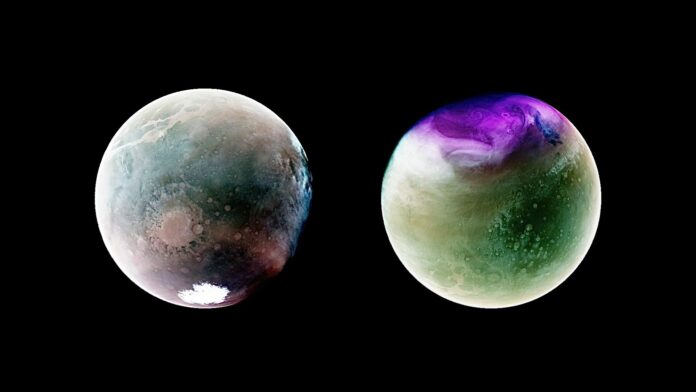Two ultraviolet photographs of our neighboring planet’s orbit around the Sun were captured by NASA’s MAVEN (Mars Atmosphere and Volatile EvolutioN) spacecraft, providing breathtaking views of Mars.
Scientists can observe surface features and learn about the Martian atmosphere by looking at the planet in UV wavelengths.
MAVEN’s Imaging Ultraviolet Spectrograph (IUVS) instrument captured these global views of Mars in 2022 and 2023 when the planet was close to the opposing ends of its elliptical orbit.
The IUVS instrument measures wavelengths between 110 and 340 nanometers outside the visible spectrum. The graphics are generated with the three UV wavelength ranges’ different brightness levels depicted as red, green, and blue to make these wavelengths visible to the human eye and simpler to understand. In this color scheme, clouds and hazes seem white or blue, while atmospheric ozone appears purple. The surface may appear tan or green depending on how the photographs have been enhanced to increase contrast and display detail.
The first photo was obtained in July 2022, during the summer months in the southern hemisphere, when Mars is closest to the Sun. Similar to how seasons change on Earth, the planet’s rotational axis tilt gives rise to the summer season. At the bottom left, Argyre Basin, one of Mars’ deepest craters, may be covered in atmospheric haze (seen here as pale pink). In the upper left, the deep canyons of Valles Marineris can be seen covered in clouds.
White at the bottom is the southern polar ice cap, which is thinning due to the summer’s comparatively high temperatures. Water vapor is propelled to high altitudes by southern summer warming and dust storms, which explains MAVEN’s observation of increased hydrogen loss from Mars at this time of year.
The second image, which shows the northern hemisphere of Mars, was captured in January 2023 after Mars had reached its orbit’s closest point to the Sun. There are a lot of white clouds because of how quickly the seasons change in the north-polar region.
At the lower left, many craters and the deep canyons of Valles Marineris can be seen. Ozone, which appears magenta in this UV picture, has accumulated throughout the freezing polar nights of the northern winter. Then, in the northern spring, it is eliminated by chemical reactions with water vapor, which is only found in the lower atmosphere at this time of year.
